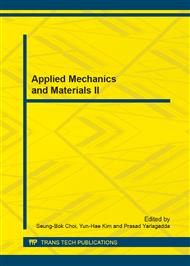p.3
p.7
p.14
p.21
p.25
p.30
p.34
p.39
p.45
Evaluation of the Higher Order Terms of the Wedge-Splitting Specimen Based on the SBFEM
Abstract:
The scaled boundary finite element method (abbr. SBFEM) is a semi-analytical method developed by Wolf and Song. The analytical advantage of the solution in the radial direction allows SBFEM converge to the Williams expansion. The coefficients of the Williams expansion, including the stress intensity factor, the T-stress, and higher order terms can be calculated directly without further processing. In the paper the coefficients of higher order terms of the crack tip asymptotic field of typical wedge splitting specimens with two different loading arrangements are evaluated using SBFEM. Numerical results show the method has high accuracy and effectiveness. The results have certain significance on determining crack stability of the wedge-splitting specimen.
Info:
Periodical:
Pages:
25-29
Citation:
Online since:
December 2013
Authors:
Price:
Сopyright:
© 2014 Trans Tech Publications Ltd. All Rights Reserved
Share:
Citation:


